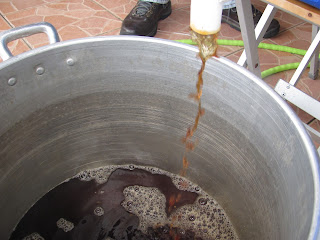It's been a while since our last post, time goes by really fast and we get so busy that we forget to update our blog but, luckly we never forget to brew!
This is the time of the year in which we approach a very special date, specially for my dear friend, college, CSO, CFO and Sanitation Engineer Solson, we are getting close to Thanksgiving! Being Solson away from US, we need to do our best to bring a little of this beautiful tradition to CR (despite that fact that we cooks a wonderful turkey, no complains!). So, we try to brew a pumpkin ale that warms our hearts and makes us proud!.
Last year we brew a descent pumpkin ale, speaking the truth it was really good but now that we have more experience we decided to take some risks and do a twist from the original recipe and decide to use Ayote instead of canned pumpkin pure!
The "Ayote" or Cucurbita argyrosperma, also the Japanese pie pumpkin or pipian or cushaw pumpkin, is a species of winter squash originally from the south of Mexico This annual herbaceous plant is cultivated in the Americas for its nutritional value: its flowers, shoots, and fruits are all harvested, but it is cultivated most of all for its seeds which are used for sauces. It was formerly known as Cucurbita mixta.
It is a Cucurbita species, with pumpkin varieties that are commonly cultivated in the United States as part of the Eastern Agricultural Complex and Mexico south to Costa Rica. Of all the cultivated Cucurbita species, it is found outside of the Americas the least. It originated in Mesoamerica and its wild ancestor is Cucurbita sororia. It is also closely related to Cucurbita kellyana and Cucurbita palmeri.
With this much similarities, we couldn't miss our target!
And so... here is what is we did (I have only a few pics... sorry about that)
First of all we had to cook the ayote, so we slow roast it for about 6 hours, seeds included!
Another important twiste we did to the recipe was our base beer, traditionally, you use a pale ale base with means that you target to get a amber - light tan color beer but, we decided to add a little more malt flavor and use a brown ale based, this would provide a sweet malt base for the body provided by the ayote and better support to the spices.
We disolved the ayote puree in the strike water and then added the grains... note to my self: this is a bit messy to clean up
We mashes at a medium temperature of 67C (dropped down to 67C about 6mins after the picture was taken and hold the temperature for the rest of the hour!
Once the mash was done.... well, you know the rest of the process, boil, add hops and spicess cool it down, get it in the fermenter and the yeast and pray to Gambrinus! hahaha
Final product: an awesome brown color, with well rounded spice flavor, not overwhelming the bitter provided by the single hop added at the beginning of the boil. This beer finished to condition about 1 month after it was bottled, it is way better that the one we tried 15 days after being bottle, we are really happy with it and we are looking forward to replicate it soon!
See you again soon!!!
Prost!








No comments:
Post a Comment